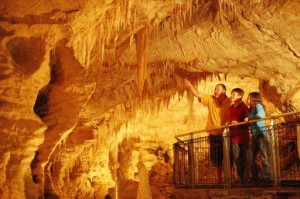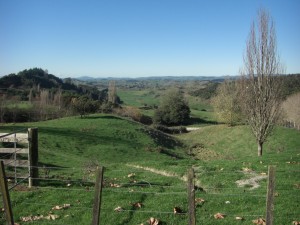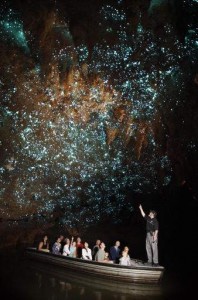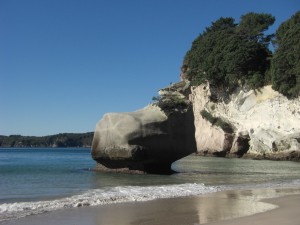“What’s going on?” I ask Terri. She has a bemused look on her face. “They must be Americans,” she says, pointing to the drivers of several cars. “They’ve been going around and around the lot.”
I laugh with California-driver disdain, start the rental, signal a left turn and wash the windshield. “Maybe you should practice, too,” she chuckles.
Like our wrong-sided rental car, New Zealand feels comfortably familiar, yet so strikingly exotic.
Down Under? I’m Not Talking Australia
“Imagine being the first person to explore this cave? You’re back in here a kilometer or so and …”
Mommy, Mommy!
Our guide has plunged Ruakuri Cave into the type of darkness that cannot be replicated, and I want my Pooh Bear doll. Removing fingernails from my wife’s forearm, I catch up with the tale: “… none of this, lights, handrails, smooth walks, was here, and if you came in with whatever you were burning so you could see, and the thing went out, you had a problem on your hands.”
Understatement.
Waitomo, some 120 miles south of Auckland, is a crumble of rolling limestone hills cast over with the emerald green that is this land’s natural cloak. Sheep and cattle do well above, rushing water (“wai”) rules down below (“tomo,” roughly). The entire district is laced with caverns, and “Dog Den” Cave could be the most elegant, and the tour serves up 90 minutes of subterranean magic: crystalline veins, sheer translucent curtains of rock, columns that peal like fine-cast bells when struck (hands off, please, let the guide gong), glowworms.
Lights are again doused as we pause on a walkway etched into an opening in the rock above a river racing through absolute darkness to a destination we can’t determine, though someone sure better know. Then we see lamps, affixed to helmets atop the heads of wetsuit-wearing, inner tube-riding adventurers. Ruakuri is a wet cave, meaning it’s still alive, and the wet is in the form of the Waitomo River, and here it’s totally “tomo.”
“Oh yeah, next time!”
Having watched too much poker on TV, Terri doesn’t hesitate in her response: “I’m all in!”
The basic wet excursion involves several hours tubing the underground river, complete with plunges, various waterfall jumps and the like. Wetsuit or not, 50-57 degree F. water is 50-57 degree F. water, and we’ll partake when we’re back some summer.
“Black rafting” demands a dose of elan and a moderate level of physical prowess. The walking tour is suitable for anyone in remotely decent shape, though there are steps, improved but often irregular walking surfaces, a few narrow, low passages and a multi-story spiral ramp—itself a cool bit of human magic—to get in/out of the cave. If that’s still too much, there’s Waitomo Glowworm Caves.
As being far out in the desert on a clear night, away from the washout of modern urbanity, the cave is a virtual cosmos of incalculable twinkles of light from the kagillions of glowworms (pssst, they’re not really worms) that hang out in such caves. The tour takes 45 minutes, 20 via boat on a quarter-mile float through the grotto. Anyone who can walk over paths, handle a few steps and get in/out of a boat can join in.
Fire in the Hole
All this stuff going on beneath our feet hints at the reason why New Zealand is New Zealand. Like Hawai’i or the Cascades or fault-zone California, Aotearoa—“the Land of the Long White Cloud” in Maori parlance—exists because of the earth’s internal engine.
Driving down the interior slope of the caldera, columns of steam here, there, all over, punctuate the crisp late-afternoon air. Rotorua proper isn’t the most geologically notable part of the North Island, though when you put a good-sized city in proximity to a region not unlike Yellowstone, people are going to take special note, and not just of the sulphur in the air.
From the Maori on, folks have been “spa-ing” at Lake Rotorua for a very long time. City and lake are set side-by-side in a broad, forested volcanic dish that last went off somewhere between the disappearance of the dinosaurs and the unfortunate advent of Lady Gaga, and though still “active,” think hot water not liquid hot magma.
Polynesian Spa offers facials, wraps and massage, yet at its core the retreat is a bathhouse, communal (clothed) or private, family or adult-only, where alkaline and acidic waters are collected in pools of various configurations as a palliative for rheumatism, arthritis, plain old itchy skin and, it is rumored, golfers suffering the yips.
Terri opts to stick with the coolest vat, coming in at 36 degrees C./97 degrees F., while I sample four—all about mid-chest level at the deepest point when this six-one footer is seated—up to the granddaddy at 108 on the Americanometer.
For a period glimpse at “taking the waters,” check out the Victorian-era Bath House nearby, now the local museum. Pausing before an old photo and some artifacts, this modern cynic realizes how seriously the people of that era took their water-cures-all obsessions: Electrical currents and big vats of water? Get out.
Twenty miles southerly of Rotorua, Wai-O-Tapu Thermal Wonderland wraps bubbling earth, mineral cave, fumarole and then some into a shutterbug’s dream of a geologic preserve. (Water we know, “tapu” means sacred.)
A warm pungent wall of cloud shields us from the signature attraction. There’s a spring just ahead, and it’s a good bit of a football-field across and as deep. A surface temp not far below the boiling point conspires with the June air to create a microclimate of marshmallow fluff fog. At the edge, the Champagne Pool reveals itself, a perfect see-through blue effervesced by carbon dioxide, the flute’s rim mineral-tinged the color of a tangerine.
The pool is easily reached using a one-mile accessible loop that also catches many of Wai-O-Tapu’s other “best” sights, including the perfectly titled Artist’s Palette: ethereal paint pots that change colors and move with water and atmospheric conditions. Additional walk-only loops and drive-to sites bring into the mix steaming waterfalls, the 60-foot Lady Knox Geyser and a several-acre, milk chocolate-hued mud pool that boils and leaps.
Linear Travelers Need Not Apply
Having a waterfront picnic in Whitianga, Terri and I take in the approaching ferry—it’s a launch, really. A handful of people disembark, having spent a grand total of 120 seconds crossing over the small harbor from Ferry Beach. We drove over. It took 35 minutes. Welcome to the Coromandel Peninsula.
The peninsula is surrounded by water on three sides, it’s not very wide and there’s a spine of mountain running right down the middle, where in season the hiking is reportedly quite grand. In short, it’s rugged and even more spectacular, and the way roads trace a track around all these hills, valleys and endless inlets I’m tempted to think Coromandel is Maori for corrugated.
Lunch comes by way of Monk Street Market, a small shop loaded large with local artisanal cheese—walnut gruyere—cured meat, breads, handmade confections and organic produce. A proper New Zealand Pinot—Triplebank—rounds out the meal. We walk off lunch strolling the wide, gentle crescent of Mercury Bay and then shop, resisting, now regrettably, the urge to lighten the wallet courtesy of a gorgeous watercolor of a nearby headland framed in wisps of flax.
With 4,000 souls Whitianga passes for a bustling metropolis up here in the Coromandel. It’s also home to The Lost Spring, a wholly contrived paradise of geothermal pools within concrete caves and alcoves studded with “stalactites,” “stalagmites” and “gems” of every color, waterways and cascades, and a Kauai-like bounty of vegetation.
“Yes, we’ll have two Margaritas and thank you very much,” Terri tells the attendant, quite pleased to have found a spa that allows an indulgence, not just monk-like gastronomic austerity. Anyway, we’re going to walk it off tomorrow.
Cliffs traced with waterfalls and capped with all things green that is New Zealand are the backdrop to four small inlets, Gemstone Bay, Stingray Bay, Mares Leg Cove and from there through the arch, Cathedral Cove—Te Whanganui-A-Hei Marine Reserve near the perfect beach hamlet of Hahei below Whitianga. A 45-minute rolling bush walk leads to the last two coves, and we descend to find a wedding party of four dressed to the nines. (Owing to erosion concerns the arch is closed to foot passage, with is accessible at low tide.) Verdant mushroom cap islets and full-blown islands color the offshore waters, and the cobalt-to-sapphire-to-aqua Pacific lazily rolls in. The South Island might reach out toward Antarctica; this is the tropics, OK, it’s at least not remotely polar. Retracing our steps we clamber down trails to Stingray and Gemstone, disappointed at the latter that we don’t have our gear so we can follow the buoyed and signed “snorkel trail” in the bay. The reserve is an ideal spot for kayaking, as well.
(The west or Auckland side of the Coromandel fronts a heavily tidal-influenced bay and if beach is your thing stick to the upper end or the Pacific side.)
A Day in Town on the Way Out
“I want to see the penguins! I want to see the penguins!”
It’s our last day in country, wrapping up our second North Island visit, we’ve had an oh-dark-30 start from the Coromandel and our flight home leaves late tonight, and I’m not exactly sure which one of us sounds like a tot too long in the back of the minivan. In the name of harmony, and with an eye toward 10.5 hours in a metal tube at altitude, we decide to see the penguins first thing when we hit Auckland.
Hopping in a fixed-track SnowCat running a short loop, we intrepid explorers head off to the great white south at Kelly Tarlton’s Antarctic Encounter and Underwater World. ZOOM! Flashes of bottom-heavy black-and-white torpedoes shoot by underwater. They’re flying. Underwater. Flying. But everything has its Achilles, and when penguins hit land—the encounter is one mondo deep-freeze with a plexiglass-contained “sea” for viewing ease, rocky shore and white stuff—they show theirs. Of course, they’re penguins, and they’re loved for their stumbling shuffle not water ballet. It’s campy and quick. So what? They’re penguins. We ride it several times.
The larger experience includes what must be one of the first walk-through aquariums, a ray encounter where the gentle giants go bonkers during feeding time, and multiple exhibits devoted to New Zealand’s onshore waters. Pay special attention to the packhorse lobsters, a local variant of the Pacific spiny lobster. The New Zealanders call them “crayfish.” If crawfish down on the bayou were the same size, the Sunday boil would have to be done in a swimming pool; packhorses can reach two feet and weigh 30-plus pounds.
By Monterey Bay Aquarium standards the underwater world isn’t, well, Monterey Bay Aquarium; not much is. It’s a hugely popular attraction featuring endemic species and if you have the kids in tow they’re better off here than bungee jumping off the Sky Tower downtown. Plus the aquarium is right around the shoreline from Mission Bay, a cozy-urban harborside enclave of tree-lined ways, shops, dogs walking their humans along the promenade, cyclists, sailboats and a UN of eats; have frites, mussels and a Trappist ale at De Fontein.
We remove our shoes entering the marae, a show of respect. The images of the ancestors, the gods are carved throughout. Though housed in a museum, this marae—a rectangular gathering place of vault, beam and lintel constructed of wood—remains venerated as a focal point of Maori spiritual and cultural life. The Auckland War Memorial Museum is a treasure trove of Maori heritage and the larger Pacific culture from which it derived. Like Te Papa, the National Museum of New Zealand in Wellington, this museum is a stirring reminder that this is a bi-cultural nation, Maori and Anglo, bound together as New Zealanders. The museum’s stories also tell more than the human tale. As the last populated major hunk of terra firma in the world, New Zealand developed a unique pre-contact community of plants and animals—no terrestrial mammals, birds that could afford to forget how to fly and grow basketball-hoop tall—and that natural history gets its due.
I’m not done with the floor ably dedicated to the nation’s military history, and the museum is closing. A guard, in true New Zealand fashion, says I can linger: “It will take us a while to usher everyone out, son, so take your time.”
I thank him.
Fifteen or so hours later we’re back at LAX. Leaving the long-term lot I signal, wash the front windshield and drive two blocks in the left lane.
Strikingly familiar. Comfortably exotic.





